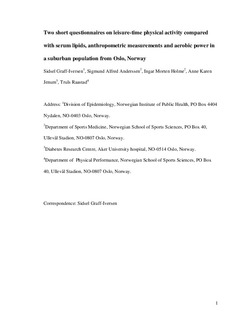| dc.contributor.author | Graff-Iversen, Sidsel | |
| dc.contributor.author | Anderssen, Sigmund A. | |
| dc.contributor.author | Holme, Ingar Morten K. | |
| dc.contributor.author | Jenum, Anne Karen | |
| dc.contributor.author | Raastad, Truls | |
| dc.date.accessioned | 2009-03-02T09:47:37Z | |
| dc.date.issued | 2007-12-19 | |
| dc.identifier | Seksjon for idrettsmedisinske fag / Department of Sports Medicine | |
| dc.identifier.citation | European Journal of Epidemiology. 2008, 23(3), 167-174 | en |
| dc.identifier.issn | 0393-2990 | |
| dc.identifier.uri | http://hdl.handle.net/11250/170531 | |
| dc.description | I Brage finner du siste tekst-versjon av artikkelen, og den kan inneholde ubetydelige forskjeller fra forlagets pdf-versjon. Forlagets pdf-versjon finner du på www.springerlink.com: http://dx.doi.org/10.1007/s10654-007-9214-2 / In Brage you'll find the final text version of the article, and it may contain insignificant differences from the journal's pdf version. The original publication is available at www.springerlink.com: http://dx.doi.org/10.1007/s10654-007-9214-2 | en |
| dc.description.abstract | The aim was to indirectly validate two short postal questionnaires measuring leisure-time physical activity (LPA) by comparing the answers with serum lipids and anthropometric measurements. Methods All inhabitants aged 31–67 years in two suburban, multicultural areas of Oslo, Norway were invited to “Romsås in Motion”, a community intervention survey, in 2000. Of those, 2950 participants (48%) met and were re-invited in 2003. LPA was measured by two short instruments used since the 1970s (referred to as the Gothenburg instrument) and since 1994 in Cohort of Norway (CONOR). Each instrument was compared with relevant measurements at baseline including LPA according to an adapted version of the long International Physical Activity Questionnaire (IPAQ-L). In addition, changes during 2000–2003 in reported LPA were compared with changes in body weight, waist-to-hip ratio, lipids and other measurements. Results LPA measured by the Gothenburg instrument correlated weakly, but consistently with relevant biological and anthropometrical measurements and with IPAQ-L. The correlation coefficients were −0.1 – −0.2 with triglycerides, total-to-high density lipoprotein (HDL)–cholesterol ratio and waist-to-hip ratio, around 0.1 with HDL–cholesterol and 0.3 with maximal aerobic power. For the CONOR instrument a similar pattern was found in both sexes for the hard LPA and in women for light LPA. LPA measured by each short instrument was in line with LPA measured with IPAQ-L. Conclusions In a multi-linguistic, suburban population in Oslo, Norway, LPA measurements by each of two short questionnaires were weakly, but consistently correlated with relevant biological and anthropometric measurements and strongly with IPAQ-L. | en |
| dc.format.extent | 86741 bytes | |
| dc.format.mimetype | application/pdf | |
| dc.language.iso | eng | en |
| dc.publisher | SpringerLink | en |
| dc.subject | physical activity | en |
| dc.subject | questionnaires | en |
| dc.subject | validation | en |
| dc.subject | VO2max | en |
| dc.subject | serum lipids | en |
| dc.subject | waist-to-hip ratio | en |
| dc.title | Two short questionnaires on leisure-time physical activity compared with serum lipids, anthropometric measurements and aerobic power in a suburban population from Oslo, Norway | en |
| dc.type | Peer reviewed | en |
| dc.type | Journal article | en |
| dc.subject.nsi | VDP::Medical disciplines:700 | |
| dc.source.pagenumber | 167-174 | en |
| dc.source.volume | 23 | en |
| dc.source.journal | European Journal of Epidemiology | en |
| dc.source.issue | 3 | en |
